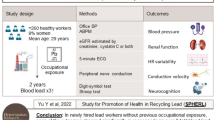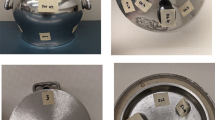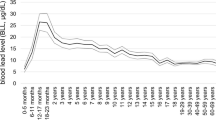Abstract
Background
In 2016 we identified a regulatory gap in Israel reflecting a lack of restrictions on lead in children’s jewelry. We conducted surveys that found high levels of lead in children’s jewelry. Following the findings, a new standard restricting lead content was introduced in 2018.
Objective
The goal of this study is to assess whether the new standard had an impact on lead concentrations in children’s jewelry on the market 4 months after entry into force, and to examine factors that influenced the standard’s effectiveness.
Methods
Thirty-five items of children’s jewelry were sampled from stores in Israel in 2018. Lead content of 130 subsamples of these items was tested with X-ray Fluorescence Spectrometry (XRF). We compared these findings to those before the introduction of the standard. We also conducted five structured interviews with professionals from government ministries, industry and expert bodies to examine factors influencing the standard’s enactment and implementation.
Results
17% of jewelry samples exceeded the ASTM lead standard in 2018 compared with 50% in 2016. The mean of the jewelry subsamples analyzed in 2018 was 936 (±1700) compared to 1420 (±5740) ppm in 2016. Scientific and regulatory consensus among those setting the new standard led to its swift enactment. However, enforcement challenges may reduce the standard’s impact.
Significance
A new standard on lead in children’s jewelry was followed by a decline in lead concentrations, but some products with lead exceedances remained available on the market. Public health campaigns, standards and compliance monitoring, and higher penalties will all help to reach the goal of protecting public health.
This is a preview of subscription content, access via your institution
Access options
Subscribe to this journal
Receive 6 print issues and online access
$259.00 per year
only $43.17 per issue
Buy this article
- Purchase on Springer Link
- Instant access to full article PDF
Prices may be subject to local taxes which are calculated during checkout

Similar content being viewed by others
Notes
E.g. https://www.ynet.co.il/articles/0,7340,L-4902923,00.html (in Hebrew).
References
Landrigan PJ, Fuller R, Acosta NJR, Adeyi O, Arnold R, Basu N(Nil), et al. The Lancet Commission on pollution and health. Lancet. 2018;391:462–512.
Chiodo LM, Covington C, Sokol RJ, Hannigan JH, Jannise J, Ager J, et al. Blood lead levels and specific attention effects in young children. Neurotoxicol Teratol. 2007;29:538–46.
Coulon F, Tian L, Ok YS, O’Connor D, Ye J, Zhang Y, et al. Lead-based paint remains a major public health concern: a critical review of global production, trade, use, exposure, health risk, and implications. Environ Int. 2018;121:85–101.
Shen Z, Hou D, Zhang P, Wang Y, Zhang Y, Shi P, et al. Lead-based paint in children’s toys sold on China’s major online shopping platforms. Environ Pollut. 2018;241:311–8.
Guney M, Kismelyeva S, Akimzhanova Z, Beisova K. Potentially toxic elements in toys and children’s jewelry: a critical review of recent advances in legislation and in scientific research. Vol. 264, Environmental pollution. Elsevier Ltd; 2020.
Weidenhamer JD, Miller J, Guinn D, Pearson J. Bioavailability of cadmium in inexpensive jewelry. Environ Health Perspect. 2011;119:1029–33.
Dix-Cooper L, Kosatsky T. Blood mercury, lead and cadmium levels and determinants of exposure among newcomer South and East Asian women of reproductive age living in Vancouver, Canada. Sci Tot Environ. 2018;619–620:1409–19.
Levin R, Brown MJ, Kashtock ME, Jacobs DE, Whelan EA, Rodman J, et al. Lead exposures in U.S. children, 2008: implications for prevention. Environ Health Perspect. 2008116:1285–93.
DTSC CD of TSC. Metal-containing Jewelry Law | Department of Toxic Substances Control [Internet]. 2020 https://dtsc.ca.gov/toxics-in-products/metal-containing-jewelry-law/. Accessed 29 Jun 2020.
DTSC CD of TSC. Toxic Jewelry Samples. 2017. https://www.dtsc.ca.gov/upload/Toxic-Jewelry-Photos-2017.pdf
European Commission. Rapid Alert System for dangerous non-food products [Internet]. 2019 https://ec.europa.eu/consumers/consumers_safety/safety_products/rapex/alerts/?event=main.listNotifications&lng=en. Accessed 21 May 2019.
Murphy T, Lim S, Kim S, Irvine K, Chaiwat W, Wilson K. Metal contamination in low-cost jewelry and toys in Cambodia. J Health Pollut. 2016;6:47–57.
Hillyer MM, Finch LE, Cerel AS, Dattelbaum JD, Leopold MC. Multi-technique quantitative analysis and socioeconomic considerations of lead, cadmium, and arsenic in children’s toys and toy jewelry. Chemosphere. 2014;108:205–13.
Negev M, Berman T, Reicher S, Balan S, Soehl A, Goulden S, et al. Regulation of chemicals in children’s products: How U.S. and EU regulation impacts small markets. Sci Total Environ. 2018;616–617:462–71.
Government of Israel. Government Decision 1857 on structural change in standardization (11 August 2016). In Hebrew; 2016.
CPSC. Test method: CPSC-CH-E1002-08.3 standard operating procedure for determining total lead (Pb) in nonmetal children’s products, revision November 15. 2012.
CPSC. Test method: CPSC-CH-E1001-08.3 standard operating procedure for determining total lead (Pb) in children’s metal products (including children’s metal jewelry), revision November 15. 2012.
Negev M, Berman T, Reicher S, Sadeh M, Ardi R, Shammai Y. Concentrations of trace metals, phthalates, bisphenol A and flame-retardants in toys and other children’s products in Israel. Chemosphere. 2018;192:217–24.
Cohen AK. The implementation of REACH: initial perspectives from government, industry, and civil society. Int J Occup Environ Health. 2011;17:57–62.
Brown P, Cordner A. Lessons learned from flame retardant use and regulation could enhance future control of potentially hazardous chemicals. Health Aff. 2011;30:906–14.
Acknowledgements
This study was funded by the Environment and Health Fund, Israel, research grants PGA 1503 and PGA 1801. We are grateful to the interviewees for their important contributions.
Author information
Authors and Affiliations
Corresponding author
Ethics declarations
Conflict of interest
The authors declare that they have no conflict of interest.
Additional information
Publisher’s note Springer Nature remains neutral with regard to jurisdictional claims in published maps and institutional affiliations.
Supplementary Information
Rights and permissions
About this article
Cite this article
Negev, M., Berman, T., Goulden, S. et al. Lead in children’s jewelry: the impact of regulation. J Expo Sci Environ Epidemiol 32, 10–16 (2022). https://doi.org/10.1038/s41370-021-00308-6
Received:
Revised:
Accepted:
Published:
Issue Date:
DOI: https://doi.org/10.1038/s41370-021-00308-6
Keywords
This article is cited by
-
Metals as toxicants in event-based expedited production of children’s jewelry
Environmental Science and Pollution Research (2023)
-
Hazardous chemicals in outdoor and indoor surfaces: artificial turf and laminate flooring
Journal of Exposure Science & Environmental Epidemiology (2022)



